When to buy bulbs
The bulb (an important part of the plant) is not only a source of nutrition, but also a way of breeding lilies.
To grow beautiful flowers, you need to purchase large, healthy bulbs. They are harvested throughout the year.
- Autumn is the best time to buy a grown crop for spring sowing, so a wide selection of varieties is offered. In addition, many stores offer large discounts for pre-orders. The only drawback is to preserve the flower bulbs before planting.
- You can buy planting material in the spring, but the choice is poorer, since interesting varieties have already been sorted out by lovers of lilies.
- It is convenient to buy bulbs just before planting. Purchased in a store and immediately planted in the country. But you only have to take the leftovers.
- When planning planting in the fall, the bulbs are bought at the end of August, but the assortment is also small. But it will save you from winter storage.

Lilies in the garden
How to choose healthy bulbs
Bulbs are planted in early autumn and late summer.
Planting material is sold in specialized stores in the spring.
When choosing, pay attention to the appearance:
- lack of mechanical damage;
- no signs of decay are visible;
- the presence of at least four roots 4–5 cm long;
- scales are evenly colored.

Beautiful lilies grow only from large and healthy bulbs
Planting material processing
Before planting, the bulbs are disinfected by keeping in a bright pink potassium manganese solution at least half an hour.
Gardeners praise means that accelerate plant growth and disinfect: epin, maxim. The soaking time of the planting material is indicated on the package.
If there are not enough healthy bulbs for planting, gardeners try to treat the diseased seed by first cleaning the damaged areas and keeping them in foundation and carbaphos.
Note! Planting material after treatment is planted separately from healthy bulbs
Growing seedlings of lilies
Many gardeners believe that it is more convenient to plant flowers in early spring with seedlings. This makes it possible to observe how the plants adapt, what problems arise, and it is easier to plan a flower bed.
Seedlings are grown at home in a container or pot.
- Pour disinfected (by roasting in the oven) earth from the garden plot into it. You can save yourself from these procedures and purchase ready-made primer in the store.
- The prepared bulbs are deepened. It is permissible to plant a lot of planting material in one pot, since the plants will be planted in a flower bed.
- During this period, seedlings are watered once a week. Do not feed. The main thing is to have light.
After 10 days, the bulbs germinate.
Important! Lily is an outdoor plant, experienced florists do not recommend growing at home, as the flower will die
Transplanting lilies in the fall
Transplanting lilies to a new place is also necessary in the fall. Try to use fresh planting material dug out this year from friends, and not bought in a store.
If you plan to leave, move and want to keep the lilies for yourself, then keep in mind that you can dig up lilies a maximum of two months before planting in a new place, but not earlier than a month after flowering. The fact is that keeping the bulbs in the refrigerator for more than a couple of months will not work, even in the cold they will begin to germinate. In nurseries and garden centers, lily bulbs are stored in special refrigerators at minus 2 ° C, but it is difficult to reproduce the exact temperature at home.

These lilies were dug up immediately after flowering, the bulbs are not ripe, small and weak, they need another 1-1.5 months after flowering to gain mass.
Transplant technique
First, you need to cut the stems at a height of about 10-15 cm above the ground. Dig up the bulbs carefully, shake off the ground. Rinse the bulbs in water and examine them. If there are spoiled scales, they need to be removed, and the bulbs should be treated in a solution of foundationol, maxim or phytosporin.
Next, you need to decide whether it is necessary to carry out the division: you want to multiply the lilies, it is better to separate those that are easily separated themselves, otherwise you still have to wait. If you do not plan to propagate, the excess bulbs just need to be removed.
If the nest of the bulbs is dense, none of the bulbs are easily separated by themselves, they can be cut off with a clean knife, but each part must have a part of the bottom with a bunch of roots.
Important: OT hybrids of lilies and LO hybrids form children much less than Asian hybrids, it is better to separate them when they are ready to break off themselves, without touching the mother bulb. For the bulbs prepared for transplantation, all cuts and breaks must be disinfected (with a fungicide) or charcoal, cinnamon
Trim the roots, leaving a root beard no more than 10 cm
For the bulbs prepared for transplantation, all cuts and breaks must be disinfected (with a fungicide) or charcoal, cinnamon. Trim the roots, leaving a root beard of no more than 10 cm.
Important: all Lily Candidum hybrids have perennial subluminous roots, they cannot be cut off, but must be protected during transplantation. Do not leave the bulbs to dry for a long time in the open air, if on the same day the transplant did not work out, or you want to save them for someone, you need to wrap the bulbs in wet sphagnum moss or wet burlap
Do not leave the bulbs to dry for a long time in the open air, if the transplant did not work out on the same day, or if you want to save them for someone, you need to wrap the bulbs in wet sphagnum moss or wet burlap.
If mice are angry on your site, there is a way to save lilies from destruction - plant them in metal or plastic nets, wire baskets
It is important that a basket or netting protects the bulbs from all sides. In this case, the plastic box from under the vegetables is not suitable - the mice will get from above.
We do not recommend planting lilies in plastic bottles with holes on the sides - if there are few holes, the lilies will suffocate.
You need to look in hardware or hardware stores for a mesh with a cell of no more than 1 cm, cut out the bottom and high walls from it, fasten them with a plastic tie. The width of the net or box should be large enough to protect the growing young bulbs, at least 30 cm in diameter if one bulb.
If the landings are large and it is impossible to land in the net, use an ultrasonic mouse repeller.
How to plant correctly?
Lilies of any variety look very beautiful on the site. In order for them to please with their flowering for more than one year, it is imperative to observe the planting technology.
If the planting material was purchased in the fall or prepared independently, but for some reason it was not planted, then until spring it must be stored in the refrigerator on the lower shelf.
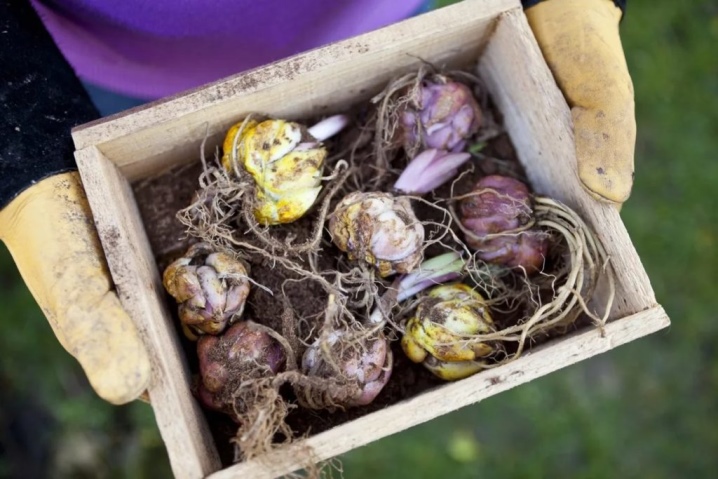
Bulbs with sprouts
If sprouts form on the bulbs, they can no longer be stored without planting. They need to be planted in pots for indoor flowers or transparent containers, having previously made small holes in them for air to enter. Transparent containers are good because in them you can better observe the peculiarities of the development of the root system. For pot planting, purchased soil for lily species or universal is suitable.
You do not need to deeply bury the onion with the sprout. According to the rules, it must be planted so that the top of the sprout is level with the ground. If the sprout has hatched recently and is very small, then its tip should be left on the surface without covering it with soil.
Place pots or containers of planted lily bulbs in a cool but well-lit area. Window sills or shelves near windows are fine.In darkened rooms, if a small amount of light hits, you can additionally use a special ultraviolet lamp.
Watering is done infrequently, once a week is enough. The plant does not need fertilizing during this period. The bulbs are kept in pots until spring, and then planted in garden beds.

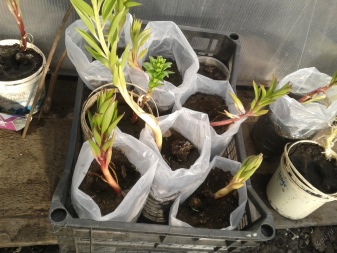
In open ground
Lily bulbs purchased in the spring can be stored in cool places, where the temperature is kept around 0 ° C, in plastic bags with small openings for air until planting.
The bulbs must be carefully checked before planting, to remove poorly adhering scales and wilted roots. In order to avoid the ingress of pathogenic bacteria, it is recommended to rinse them in clean water and immerse them in a weak solution of potassium permanganate for 20-30 minutes.
It should be planted in pre-prepared soil. It is necessary to dig up the area, add and mix the additives necessary for a particular type of lily, and arrange a flower bed with a height of about 20 cm.
There are practically no differences when planting ordinary bulbs and those grown with sprouts in open ground. If the sprout has grown by more than 15 cm, then it can be placed in the hole under a slight lateral slope, so that one side is closer to the ground, and the sprout itself does not stick out too much above its surface. This method will protect delicate shoots from frost. In two weeks, the sprouts will again assume an upright position, and they will no longer be afraid of spring temperature drops.
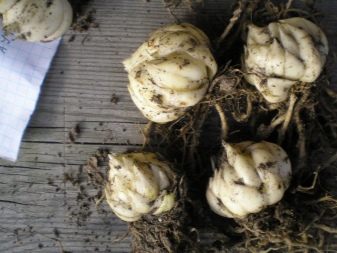
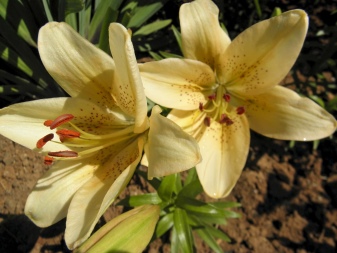
We list the main stages of planting.
- Preparation of planting holes. When digging them up, you need to focus on the description of the variety and the size of the bulb. The depth of the grooves should correspond in height to 3 bulbs placed on top of each other - about 8-12 cm.Leave the distance between them at 15-20 cm for low-growing varieties, for tall representatives - 20-30 cm.
- Planting bulbs. Place a small layer of small drainage stones or sand at the bottom of each hole. If possible, you can add sphagnum moss, as it has bactericidal properties and will protect the plant from decay and other diseases. Lower the onion on this layer and carefully spread the roots, then pour sand on top again. It is needed to absorb moisture.
- It is good to sprinkle the bulbs with soil, close the holes (except for those in which specimens with grown sprouts are planted), you can add a little peat and water abundantly.
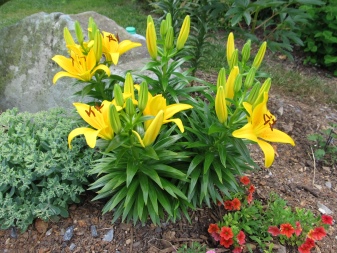
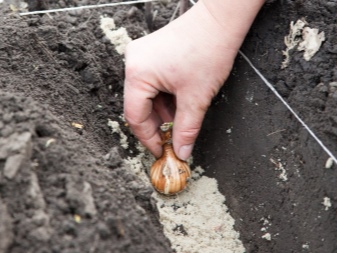
When is the best time to plant
Usually summer residents prefer to plant lilies in the fall. This is competent from the point of view of the biological cycle of the lily: after completing its flowering, it begins to prepare for winter. The corm restores the energy spent on luxurious flowers, stores nutrients, and then plunges into a state of rest. It is this time that is favorable for planting. The plant wakes up pretty quickly, builds up the root system and its own body. This is intended by nature, its wise decision should not be contradicted.
Important! Lilies planted in autumn form significantly more daughter bulbs, better adapted for independent living

Lilies
Optimal planting schedule by region:
- Middle band: mid-September - end of October;
- Ural: early September - early October;
- Siberia: September;
- South of Russia, Ukraine: from early September to late November.
It is important to follow the order of landing:
- always start with candidum blooming in June;
- then lilies of American and Caucasian origin are planted;
- finish planting with oriental, tubular, tiger, Tibetan, Asians can be planted in summer.
When to plant lilies in open ground in the fall, they are determined by the air temperature - it should be around + 10 ° C. In warmer weather, the bulb will grow, in cold weather, it will not have time to take root, it will endure the winter worse.

Planting lilies in the fall
Onions manage to settle in a new place, to get stronger before the winter cold.With the very first warm days, they begin their growth, and the return frosts of April-May endure without catastrophic consequences.
Important! Candidums, martagons, some oriental hybrids are planted at the end of August (for Siberia, the deadline is the middle of the month). In the spring, lilies are planted, which are not adapted to the harsh winter - most orientals, all American, tubular and derived hybrids, late flowering Asiatic lilies
The optimal period is considered mid-April, the determining factor is that the soil has completely thawed, moderately warmed up. In the south, garden lilies are planted earlier.
In the spring, lilies are planted, which are not adapted to the harsh winter - most orientals, all American, tubular and derived hybrids, late flowering Asiatic lilies. The optimal period is considered mid-April, the determining factor is that the soil has completely thawed, moderately warmed up. In the south, garden lilies are planted earlier.
When planting in spring, the sequence is also observed when planting lilies of certain types: the first to plant are tiger, Tibetan, and the last - terry, as they are more demanding for heat.
Note! Water lilies are planted only in spring. Also, in the spring, they postpone the planting of bulbs, which for various reasons did not land in the autumn:
Also, in the spring, they postpone the planting of bulbs, which, for various reasons, were not planted in the fall:
- sudden early persistent cold;
- the planting material was purchased at the end of the season sale;
- the package with the ordered nodules arrived late.

Storing the bulbs
This situation necessitates the storage of the bulbs. There are several rules to help preserve them until spring:
- before laying for storage, the bulbs are examined, damaged areas are cut off, disinfected;
- carry out anti-fungal treatment with potassium permanganate, a solution of any fungicide;
- dry the material in a dark cool room.
Store wrapped in paper or sprinkled with sawdust. For storage, a ventilated room with moderate humidity is suitable, where the temperature is kept at 3-5 ° C. A small number of corms are kept in the refrigerator.
Important! Planting material requires care: it is regularly checked in order to timely identify tubers that have begun to mold or rot, as well as those that have begun to sprout. Diseased bulbs are processed, stored, sprouted are planted in pots
Disembarkation scheme
After the bulbs have been prepared, they can be safely planted in the ground. For this, it is better to prepare individual dimples or long holes. If the ground is too dry, they can be slightly moistened. At the bottom of each, a drainage layer should be poured, at least from sand. Top dressing is added directly to the pits. Then, in them strictly vertically, with the bottom down, set the onions and cover them with earth from above.
Planting density and density may vary. Lilies are almost never planted alone; in groups they look more organic. A flower bed with often planted flowers looks better, but in this case, perennials will have to be transplanted more often, as they grow larger and the children grow. Better to keep the distance between the bulbs the same (5 to 25 cm), especially for linear planting.


Another aspect that raises many questions is the planting depth. On this score, one can come across completely different opinions. It depends on the following factors:
- variety - low-growing ones are buried by 10–12 cm, lilies of medium height - by 15 cm, tall ones - by 20–25 cm; there are certain varieties with low-laid leaves - it is enough to sprinkle them only slightly with earth;
- the size of the bulb - if it is small, then the depth can be reduced;
- the selected area - in loose, soft soil, the pits should be deeper, this method is more reliable and retains moisture better, especially when it comes to arid regions, but this may slightly delay the timing of germination and flowering.

Naturally, the landing should not be spontaneous. There are many ideas for decorating flower beds, but they are all subject to the following principles:
it is important to choose a good background for lilies - it can be a fern, juniper or any other shrub of this kind, while high varieties do not look at all against the background of low and rare plantings - they will stand out excessively; on a rounded flower garden, they are usually located in the central part;
undersized lilies will perfectly fit into any flower bed, and are also suitable for decorating paths, highlighting zones on a personal plot;
so that the flower garden always looks elegant, next to them you can plant flowers that bloom at different times, for example, phlox, peonies and gladioli;
in addition to the size of the plant and the shape of the flower, you should carefully choose the color scheme - flowers can contrast with others or emphasize similar shades;
when distributing space for different types of flowers, it is necessary to make sure that the faded ones are at least partially covered by other plants;
different varieties of lilies are planted together with great care, as they may have different conditions of detention, and this will also prevent the spread of diseases from the most vulnerable varieties.
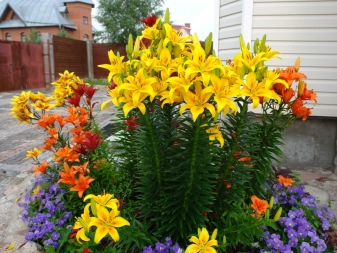

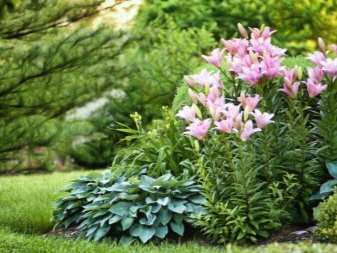
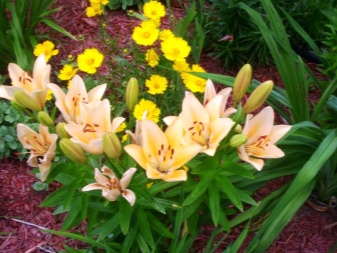
When to transplant lilies
The most optimal time for planting Asiatic lilies and LA hybrids is in autumn, with spring planting, lilies can bloom only after a year, or bloom in the current year, but much weaker. Although the problem with the autumn planting of lilies arises if you do not guess the timing: when the autumn is warm and lingering, some bulbs can germinate after planting, under cover, we will not see how frosty sprouts are covered with ice, and such lilies do not bloom next year, or completely freeze out.
In general terms, planting dates depend on the climate in your area - in the southern regions of Russia they are traditionally planted later - in October-November, in the northern ones - no later than September, in the Moscow region and the Central region - September-October. During these periods, lilies have time to take root perfectly before winter.
Oriental lilies and OT hybrids in central Russia are best planted in the spring, since they have later flowering periods and by the beginning of autumn the bulbs are not yet ready for planting. But if autumn promises a long and warm one, it is quite possible to plant Oriental lilies in October, they will have time to take root. If autumn is cold, damp and early cold, postpone planting until spring, when the soil warms up well.
The general rule for digging out the bulbs for transplanting or reproduction: a month or one and a half after flowering.
Planting bulbs
Before planting, you need to protect the plants from diseases, for this it is worth soaking the bulbs in the Maxim preparation, or in a strong solution of phytosporin-M with the addition of a stimulant zircon.
Rules for deepening lily bulbs: the depth does not depend on the height of the variety, but on the size of the bulb - the optimum is 3 bulb heights. The larger the bulbs, the deeper they need to be buried, but even the largest ones are no deeper than 25 cm from the soil surface.
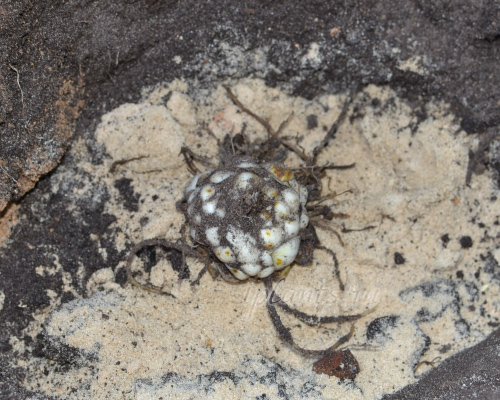
Add another 5 cm to this depth, i.e. make the hole deeper, and pour 5 cm of coarse river sand on the bottom. Then plant the bulbs on a sand cushion. The roots must be gently spread to the sides.
Candidium hybrids never bury deep, sprinkle a maximum of 3 cm with earth.
The distance between the bulbs of oriental or tubular lilies is 20 cm. Asiatic lilies grow faster, they need to be planted less often - leave 30 cm between the bows, when planting LO hybrids and OT hybrids, the distance between the bulbs increases to 40-45 cm.
Small daughter bulbs of lilies should be planted to a depth of about 5-7 cm in pots (containers) or a separate "children's" flower bed for growing, and only after a year or two they will be transplanted to a permanent place in a flower garden.
After planting, the bulbs need to be watered, but without zeal, not like vegetables. Then mulch, preferably with straw.Continue watering regularly, but make sure the soil under the mulch is dry before watering.
If you bought autumn lily bulbs with sprouts, what to do with them if it is out of season, for example, at the end of summer? Lily bulbs that have sprouts are determined to immediately move to build up stems and are even ready to bloom, and this is highly undesirable. These bulbs have a 1: 1 chance of surviving. And only if you gently break off the sprouts and leave the bulbs until optimal planting times in the refrigerator in the vegetable compartment, packed in slightly damp sphagnum moss. By the way, scraps need to be powdered with coal, ground cinnamon or foundation powder. Then wait until autumn and drop off at the prepared place.
If you nevertheless planted lily bulbs with sprouts in August or September, they have sprouted and are even going to bloom, do not allow this, just remove the buds, and warm the plants properly for the winter.
What you need to know about spring planting lilies?
The gardener should be aware that the spring planting of these flowers is different from the autumn planting. Both culture and soil need additional processing.
Beautiful, tall lilies are obtained from quality bulbous seeds. They must be free from defects, stains, mold, rot. Their texture and color must be healthy. It means that:
- the roots should be elastic, white, yellow, strong, that is, "live", not dry, and have a length of up to five centimeters
- the bulbs must be free from defects, juicy, with overlapping scales. Of these, small bulbous ones will grow over time.
Adult bulbs do not have covering scales, therefore, they need to be provided with high-quality storage, without drying out, damage.
When buying in the spring, it is better to pay attention to bulbs with young shoots. When self-preparation of seed, they are placed in a refrigerator, in peat, in a bag with holes for ventilation
This will make it possible to control their well-being. If arrows appear early, to preserve the sprouts, the onions are moved to simple pots with loose earth. At the end of the frost period, all specimens are planted in flower beds in prepared soil, but they must first be subjected to simple preventive disinfection. For this purpose, the bulbs:
For self-preparation of seed, they are placed in a refrigerator, in peat, in a bag with holes for ventilation. This will make it possible to control their well-being. If arrows appear early, to preserve the sprouts, the onions are moved to simple pots with loose earth. At the end of the frost period, all specimens are planted in flower beds in prepared soil, but they must first be subjected to simple preventive disinfection. For this purpose, the bulbs:
- washed under running water, then placed for thirty minutes in a low concentration manganese solution (10 grams per bucket of water)
- according to the manual are kept in fungicide
- if there are infections, they are washed in three waters and placed in a solution of a broad-spectrum insecticide (1 tablespoon per bucket of water).
To improve survival, it is advisable to insulate the planting site. You can use the most common method - cover with cut and inverted plastic utensils of any kind. Such an event creates a greenhouse effect for young sprouts.
When transported for several days, they can be placed in any containers, covering them with moist loose earth, sawdust, peat, moss.
If a gardener prefers Asian hybrids, he needs to know that they reproduce by bulbs that appear on the stem in the leaf sinuses. During the winter cold, they are perfectly preserved in plastic bags placed in peat pots. The containers can be kept in a cool dry place.
When buying young bulbs, you need to familiarize yourself with the variety.The varieties differ in terms of timing, suitable planting site, maintenance requirements, and methods of cultivation.


